When it comes to the world of Westeros, the power and influence of the noble houses greatly shaped the course of history and the fate of its people with each house having its own unique legacy, marked by glorious moments, tragedies, and important decisions that affected it the course of empire. These noble families have played important roles in wars, alliances and the ever-changing politics of the Seven Kingdoms, their deeds have been intertwined over generations and their castles such as Winterfell, Casterly Rock and Dragonstone are not physical structures merely but their enduring symbolic power and influence. House Targaryen, with his dragons and conquest of Westeros left a legacy of fire and blood, while House Stark’s honor and resilience foreshadowed the latter and House Lannister’s wealth and cunning have cemented their status as if families the strength of one of their most dangerous. Other houses, such as the Baratheon, Martell, and Tyrell, also contributed significantly to local history. In this article, we present top 10 most powerful houses in Westeros in Game of Thrones, highlighting their incredible legacies and the indelible marks they left on the Seven Kingdoms. Get to know these legendary families and their lasting impact at Cande Pie.
10. House Arryn

House Arryn is one of the oldest and most prestigious noble houses in Westeros, tracing its lineage back to the Andal invasion. Their seat is the Eyrie, a formidable castle high in the Mountains of the Moon, known for its impregnable defenses. The Arryns have long ruled the Vale of Arryn, a fertile and strategically important region.
The founder, Ser Artys Arryn, known as the Winged Knight, was a legendary figure who established the house’s dominance by defeating the First Men and claiming the Vale for the Andals. House Arryn played a crucial role in the Andal invasion, bringing their customs and faith to Westeros.
Throughout history, the Arryns have been known for their honor and integrity, often compared to the Starks of the North. They were key allies to Aegon the Conqueror during his conquest, securing their place as one of the Great Houses of Westeros. The Arryns also maintained their influence by marrying into other powerful houses.
During Robert’s Rebellion, Jon Arryn served as a mentor to both Eddard Stark and Robert Baratheon, fostering a crucial alliance that led to the overthrow of the Mad King. Despite their relative seclusion, the Arryns have remained a powerful and respected house in the political landscape of Westeros.
9. House Greyjoy
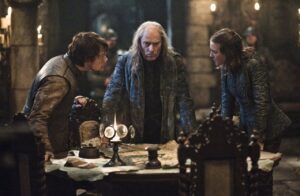
House Greyjoy is one of the Great Houses of Westeros, ruling over the Iron Islands from their seat at Pyke. Their motto, “We Do Not Sow,” reflects their seafaring, raiding culture. The Greyjoys claim descent from the Grey King, a legendary figure who ruled the Iron Islands thousands of years ago and is said to have taken a mermaid as his wife.
House Greyjoy’s power is derived from their naval strength and the rugged, independent nature of the Ironborn. They have a unique culture centered around the “Old Way,” which glorifies raiding and paying the “iron price” for wealth rather than the “gold price.”
During the Targaryen conquest, the Greyjoys submitted to Aegon the Conqueror, but they retained a degree of autonomy. Balon Greyjoy led a failed rebellion against the Iron Throne, resulting in the death of his two eldest sons and the fostering of his youngest son, Theon, as a hostage by House Stark.
Theon’s return to the Iron Islands and subsequent betrayal of the Starks reignited the Greyjoys’ ambitions. However, their efforts to assert dominance over the North and the Riverlands ultimately failed. The Greyjoys remain a formidable force due to their naval capabilities, but their rebellious spirit often puts them at odds with the mainland powers.
8. House Tyrell
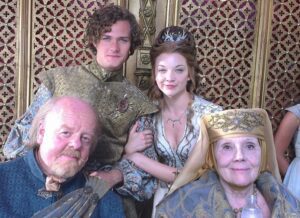
House Tyrell, one of the Great Houses of Westeros, traces its lineage to the legendary Garth Greenhand, an ancient King of the Reach. Their seat, Highgarden, is a lush and fertile region known for its wealth and beauty. Initially stewards to House Gardener, who ruled as Kings of the Reach, the Tyrells rose to prominence after Aegon the Conqueror’s invasion.
When King Mern IX Gardener fell at the Field of Fire, the Tyrells surrendered Highgarden to Aegon, who rewarded them with lordship over the Reach. This act secured their status as Wardens of the South. Under Tyrell leadership, the Reach flourished, known for its chivalry, bountiful harvests, and strong alliances.
Mace Tyrell, during Robert’s Rebellion, initially supported the Targaryens but later bent the knee to Robert Baratheon. The Tyrells gained substantial influence during the War of the Five Kings, aligning with Renly Baratheon and later King Tommen Baratheon through Margaery Tyrell’s marriages.
Their ambition led to conflict with the Lannisters and eventual tragedy. The destruction of the Great Sept of Baelor by Cersei Lannister resulted in the deaths of Mace, Margaery, and Loras Tyrell, marking the house’s decline. Olenna Tyrell, the formidable matriarch, sought revenge but ultimately faced the end of her line, marking a significant downfall for House Tyrell.
7. House Martell

House Martell, ruling from the sun-scorched lands of Dorne, traces its origins to the legendary warrior queen Nymeria of the Rhoynar. Fleeing the Valyrian Freehold, Nymeria led her people across the Narrow Sea and allied with Lord Mors Martell through marriage, combining their forces. Together, they unified Dorne under Martell rule, with Sunspear as their seat.
Distinct in Westeros, House Martell maintained independence even after Aegon the Conqueror’s invasion. Despite multiple Targaryen attempts to subdue Dorne, the Martells used guerrilla warfare and the harsh desert terrain to their advantage. Peace was eventually achieved through marriage alliances, with Daeron II marrying Princess Myriah Martell.
Dorne’s distinct culture and customs persisted, valuing equality and tolerance. House Martell’s motto, “Unbowed, Unbent, Unbroken,” reflects their resilient spirit. During Robert’s Rebellion, Dorne sided with the Targaryens, resulting in the brutal deaths of Princess Elia Martell and her children at the hands of Lannister forces.
In the War of the Five Kings, Prince Doran Martell harbored a long-simmering desire for revenge against the Lannisters. His brother Oberyn Martell, known as the Red Viper, sought justice but was killed in a trial by combat. The death of Doran and the rise of Ellaria Sand marked a tumultuous period, ultimately leading to Dorne’s diminished influence.
6. House Durrandon
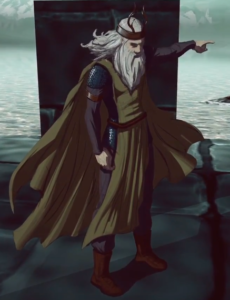
House Durrandon, an ancient and storied lineage, once ruled the Stormlands from their seat at Storm’s End. Their origins trace back to the legendary figure Durran Godsgrief, the first Storm King. According to legend, Durran defied the gods by marrying Elenei, the daughter of a sea god and a wind goddess, prompting the deities to unleash their fury upon him. Despite their wrath, Durran built Storm’s End, a mighty fortress said to be enchanted by Bran the Builder to withstand the gods’ storms.
For thousands of years, the Durrandons maintained dominion over the Stormlands, fending off invasions and solidifying their rule through strength and strategic marriages. They were known for their fierce warriors and resilience, traits necessary for survival in the storm-lashed region.
Their reign came to an end during Aegon’s Conquest. Argilac the Arrogant, the last Storm King, resisted Aegon Targaryen’s advance. Argilac met his end in battle, and his daughter, Argella Durrandon, was captured. She was eventually married to Orys Baratheon, Aegon’s half-brother, who was granted Storm’s End and the Stormlands as a reward. This union established House Baratheon, absorbing the legacy of the Durrandons and marking the end of their ancient line.
5. House Hoare
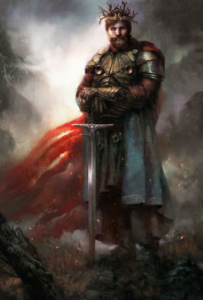
House Hoare, known as the Black Harren Hoare, once ruled the Riverlands and the Iron Islands. Their rise to power began when King Harwyn Hoare, known as Harwyn Hardhand, conquered the Riverlands, extending Ironborn influence far inland. The Hoares ruled from Harrenhal, a massive castle built by Harren the Black, Harwyn’s grandson.
Harrenhal’s construction was a monumental feat, intended to be the greatest castle in Westeros, symbolizing the might and ambition of House Hoare. However, its completion coincided with Aegon the Conqueror’s invasion. Harren the Black, known for his cruelty and tyranny, defied Aegon, believing Harrenhal’s thick walls were impregnable.
On the night of Aegon’s assault, Harren and his sons were incinerated alive by Aegon’s dragon, Balerion the Black Dread, marking the end of House Hoare. The castle’s ruins became a symbol of hubris and doom, forever cursed.
House Hoare’s downfall reshaped the political landscape. The Iron Islands fell under the rule of House Greyjoy, while the Riverlands were granted to House Tully. The swift and fiery demise of House Hoare remains a cautionary tale of overreaching ambition and the devastating power of dragons.
4. House Baratheon
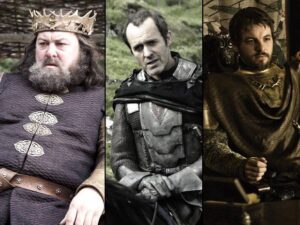
House Baratheon, one of the Great Houses of Westeros, traces its origins to Orys Baratheon, a reputed half-brother of Aegon the Conqueror. After defeating the last Storm King, Argilac the Arrogant, Aegon rewarded Orys with the Stormlands and the formidable fortress of Storm’s End, establishing House Baratheon. Orys solidified his rule by marrying Argilac’s daughter, Argella, merging the Durrandon lineage with his own.
For centuries, House Baratheon remained loyal to the Targaryen kings. However, this loyalty fractured during Robert’s Rebellion. Robert Baratheon, a charismatic and formidable warrior, led the rebellion against King Aerys II Targaryen, spurred by the alleged kidnapping of Lyanna Stark. Robert’s victory at the Battle of the Trident and subsequent ascension to the Iron Throne ended centuries of Targaryen rule, beginning the Baratheon dynasty.
Robert’s reign was marked by his disinterest in governance and financial mismanagement. His death during a boar hunt triggered the War of the Five Kings, where his brothers Stannis and Renly vied for the throne. Stannis, a stern and unyielding leader, held Dragonstone, while Renly, charismatic and popular, claimed the Stormlands. Both brothers met tragic ends.
The Baratheon line faced further turmoil with the rise of the Lannisters and the emergence of Robert’s purported son, Joffrey, whose true parentage was revealed to be from incest between Cersei and Jaime Lannister. House Baratheon’s fortunes waned as internal strife and external challenges eroded their power, leaving their legacy marred by conflict and ambition.
3. House Lannister

House Lannister, one of the wealthiest and most powerful families in Westeros, traces its origins to the legendary figure Lann the Clever, who purportedly tricked the Casterlys out of their stronghold, Casterly Rock. Their seat, Casterly Rock, overlooks the Sunset Sea and contains vast gold mines, making the Lannisters immensely wealthy.
The Lannisters became Kings of the Rock before bending the knee to Aegon the Conqueror during his invasion. As Wardens of the West, they maintained significant influence. During the reign of King Robert Baratheon, Tywin Lannister served as Hand of the King, bringing wealth and political acumen to the royal court.
Tywin’s children played crucial roles in Westerosi politics. Cersei married Robert Baratheon, becoming queen and later ruling as queen regent for her sons, Joffrey and Tommen. Jaime, a renowned swordsman, served in the Kingsguard. Tyrion, the clever but underestimated dwarf, became Hand of the King to Joffrey and later Daenerys Targaryen.
The Lannisters’ quest for power and ruthless political maneuvers, epitomized by the infamous Red Wedding, earned them many enemies. Their dominance was challenged during the War of the Five Kings and the rise of Daenerys Targaryen. The deaths of Tywin, Joffrey, and later Cersei and Jaime during the destruction of King’s Landing by Daenerys’ dragon marked the end of their reign.
Despite their fall, the Lannisters remain one of the most memorable and influential families in Westeros, symbolizing the lethal combination of wealth, ambition, and power.
2. House Stark

House Stark, one of the oldest and most honorable houses in Westeros, traces its lineage back to the First Men and the legendary Bran the Builder, who constructed Winterfell and the Wall. As Kings in the North, the Starks ruled the vast and harsh region of the North from their ancestral seat at Winterfell for millennia, upholding values of honor, duty, and loyalty.
The Stark motto, “Winter is Coming,” reflects their constant vigilance and preparedness for hard times. During the Targaryen conquest, Torrhen Stark, the last King in the North, bent the knee to Aegon the Conqueror, earning the title Warden of the North.
Eddard “Ned” Stark, the honorable and steadfast patriarch, played a pivotal role in Robert’s Rebellion, helping to overthrow the Targaryen dynasty. He became Warden of the North and later Hand of the King to Robert Baratheon. Ned’s execution for treason, orchestrated by the Lannisters, sparked the War of the Five Kings and marked the beginning of the Starks’ trials.
Robb Stark, Ned’s eldest son, was declared King in the North but was betrayed and killed at the Red Wedding. The surviving Stark children faced numerous hardships: Sansa endured captivity and manipulation in King’s Landing, Arya trained as an assassin with the Faceless Men, Bran became the mystical Three-Eyed Raven, and Jon Snow, Ned’s purported illegitimate son, rose to prominence as a leader of the Night’s Watch and later as King in the North.
House Stark’s resilience and honor eventually led to their resurgence, with Sansa becoming Queen in the North and Bran being chosen as King of the Six Kingdoms, ensuring the Stark legacy endured in the face of immense adversity.
1. House Targaryen

House Targaryen, one of the most iconic families in Westeros, traces its origins to the Valyrian Freehold, a powerful empire known for dragonlords. Fleeing the Doom of Valyria, the Targaryens settled on Dragonstone. A century later, Aegon the Conqueror and his sister-wives, Rhaenys and Visenya, launched their conquest of Westeros. Aegon united six of the seven kingdoms, establishing the Iron Throne and beginning a dynasty that lasted nearly 300 years.
The Targaryen rule was marked by both greatness and turmoil. Kings like Jaehaerys I, the Conciliator, brought peace and prosperity, while others like Maegor the Cruel incited fear and rebellion. The Targaryens’ practice of incestuous marriages kept their bloodline pure but often led to madness and internal strife, exemplified by the Dance of the Dragons, a devastating civil war between rival Targaryen factions.
The reign of Aerys II, the Mad King, ended in chaos. His increasing paranoia and cruelty led to Robert’s Rebellion. Aerys was slain by Jaime Lannister, and his children, Viserys and Daenerys, fled into exile. Robert Baratheon seized the throne, ending the Targaryen rule.
Years later, Daenerys Targaryen emerged as a significant player, determined to reclaim the Iron Throne. With three dragons, she amassed a formidable following. Despite her initial success and liberation of many from tyranny, her descent into ruthlessness and the subsequent destruction of King’s Landing by her dragon led to her assassination by Jon Snow, her nephew and lover, ending the Targaryen bid for power.
